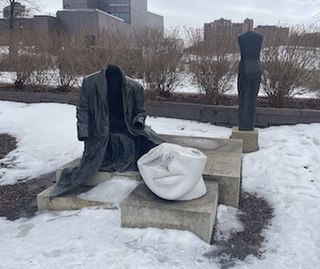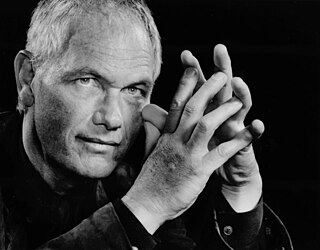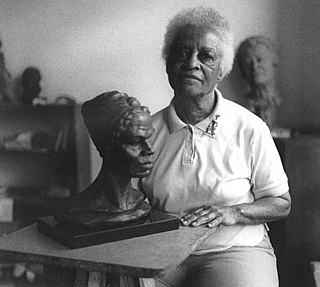The topic of this article may not meet Wikipedia's notability guideline for biographies .(July 2011) |
Peter Rubino (born 1947) is an American master sculptor. [1]
The topic of this article may not meet Wikipedia's notability guideline for biographies .(July 2011) |
Peter Rubino (born 1947) is an American master sculptor. [1]
Peter Rubin was born in 1947 in Brooklyn, New York. His formal art training was at the National Academy of Design and the Art Students League in Manhattan, New York
He has created likenesses of such notables as: American actor, David Canary; American jazz pianist, Dave Brubeck; the leader of the Trinidad and Tobago Teachers Union (TTTU), St. Elmo Gopaul; and NYPD Police officer and hero, Kenneth Hansen of the 61st Precinct, Brooklyn, New York.
Forming a business partnership "Rudolf-Rubino Creations", with former U.S. Senator Jack Rudolph he created busts of Babe Ruth, Ty Cobb, Lawrence Taylor, Don Mattingly, Mickey Mantle and Lou Gehrig. Former General Manager of the New York Rangers, Phil Esposito, commissioned the partnership to create a figure of the goalie Eddie Giacomin, and it was presented to him when his jersey number was retired.
They met and became friends at the Silvermine Artists Guild, in New Canaan. Mr. Rudolf decided that he would take care of the business details while Mr. Rubino produced the heroic sculptures envisioned. [2]
His abstract commissions include: in 1983 an 11-foot work entitled, "Mother of All Life," at the Boyko Research Center at Ben Gurion University in Beer Sheva, Israel; in 1991 a 7-foot sculpture entitled, "Eagle" depicting a boy in the Eagle Scout uniform; and in 1997 a 35-foot monumental entitled, "Angel" created for The Walt Disney Company.
"The Portrait in Clay" which is distributed world wide by Random House (Watson Guptill) and has been translated into Russian and Chinese. [3]
"Sculpting the Figure in Clay", An Artistic and Technical Journey to Understanding the Creative and Dynamic Forces in Figurative Sculpture (Watson-Guptill Publications, $32.50, April 27, 2010), foreword written by jazz icon Dave Brubeck. It is a comprehensive instructional guide to sculpting the human figure in clay, meant to simulate the classroom experience. This all-inclusive volume lays out an easy-to-follow, step-by-step method of blocking out the plane structure and anatomy of the posed figure. His unique approach utilizes a geometric system consisting of blocks, simple shapes, and guidelines, which instructs students with new and instinctive sculptural insight. Sculptural concepts are illustrated through a sequence of dramatic photos of the model, taken from every angle in a given pose, and the entire sculpting process is shown from start to finish, with accompanying text. The unique approach covered in this book, including overlays and many photographic reference poses for continued study, will define a fresh and spirited sculptural language enabling artists to create expressive figures with individual style.
He has taught the art of sculpting for over thirty-five years. He was an instructor at The Brooklyn Museum Art School, the Silvermine Artists Guild, The National Academy School of Fine Art in New York City. [4]
He teaches annual workshops in the United States and Italy. [5]
He also conducts workshops at the Scottsdale Artists' School in Arizona. [5]
Mr. Rubino has produced several performance videos demonstrating his art of sculpting: "Symphony in Clay", "Symphony in Clay II", "Extreme Sculpting", "Extreme Sculpting Gone Wild", "Sculpting the Female Torso", "Making of a President", "Peter Rubino Portrait Sculpture Evolution" and "aWARness". [6]

François Auguste René Rodin was a French sculptor, generally considered the founder of modern sculpture. He was schooled traditionally and took a craftsman-like approach to his work. Rodin possessed a unique ability to model a complex, turbulent, and deeply pocketed surface in clay. He is known for such sculptures as The Thinker, Monument to Balzac, The Kiss, The Burghers of Calais, and The Gates of Hell.

Harry Bates was a British sculptor. He was elected to the Royal Academy in 1892 as A.R.A. and was an active, if intermittent, member of the Art Workers Guild. He was a central figure in the British movement known as New Sculpture.

The history of sculpture in the United States begins in the 1600s "with the modest efforts of craftsmen who adorned gravestones, Bible boxes, and various utilitarian objects with simple low-relief decorations." American sculpture in its many forms, genres and guises has continuously contributed to the cultural landscape of world art into the 21st century.
Alice Aycock is an American sculptor and installation artist. She was an early artist in the land art movement in the 1970s, and has created many large-scale metal sculptures around the world. Aycock's drawings and sculptures of architectural and mechanical fantasies combine logic, imagination, magical thinking and science.

Stephen De Staebler was an American sculptor, printmaker, and educator, he was best recognized for his work in clay and bronze. Totemic and fragmented in form, De Staebler's figurative sculptures call forth the many contingencies of the human condition, such as resiliency and fragility, growth and decay, earthly boundedness and the possibility for spiritual transcendence. An important figure in the California Clay Movement, he is credited with "sustaining the figurative tradition in post-World War II decades when the relevance and even possibility of embracing the human figure seemed problematic at best."
Milton Elting Hebald was a sculptor who specialized in figurative bronze works. Twenty-three of his works are displayed in public in New York City, including the statues of Romeo and Juliet and The Tempest in front of the Delacorte Theatre in Central Park. His major work is a 220-foot (67 m), 12-piece "Zodiac Screen", then the largest sculpture in the world, commissioned by Pan-American Airlines for its terminal at John F. Kennedy International Airport, and now owned and stored by the Port Authority of New York and New Jersey.

Judith Shea is an American sculptor and artist, born in Philadelphia, Pennsylvania, in 1948. She received a degree in fashion design at Parsons School of Design in 1969 and a BFA in 1975. This dual education formed the basis for her figure based works. Her career has three distinct phases: The use of cloth and clothing forms from 1974 to 1981; Hollow cast metal clothing-figure forms from 1982 until 1991; and carved full-figure statues made of wood, cloth, clay, foam and hair beginning in 1990 to present.

Blake Ward is a Canadian-born sculptor best known for his contemporary approach to the classical figure. Contrary to the trend toward abstraction that was taught during his formal education in Canada, Ward's early work centred on the figure. Evolving through the 1990s and early 2000s into contemporary partial figures created as excerpts of the human condition. In the words of Art Critic Jacqueline Ceresoli "Bodies in metamorphosis, balanced between apocalypse and the Postmodern, steeped in a lost Classical age, echoed through an ever-evolving Renaissance, in vibrant tension or torsion as they head toward some future utopia." Ward has been exhibited in France, Monaco, Italy, Germany, England, Singapore, India, Hong Kong, the United States and Canada.

Beth Cavener, also known as Beth Cavener Stichter, is an American artist based out of Montana. A classically trained sculptor, her process involves building complex metal armatures to support massive amounts of clay. Cavener is best known for her fantastical animal figures, which embody the complexity of human emotion and behavior.

Casey Stengel a public sculpture by American artist, Rhoda Sherbell, is located on the Indiana University-Purdue University Indianapolis campus, which is near downtown Indianapolis, Indiana. The sculpture can be found in the courtyard of the University Place Hotel. Installed in 2000, the sculpture was cast in bronze with a height of 43 inches.
Pablo Eduardo is a Bolivian sculptor. He creates a wide variety of sculptures for many purposes. Although he sculpts in many different countries, most of his major works have been made in the United States, England, and Bolivia.
Joseph Francis Menna is an American sculptor and engraver who has worked in both digital and traditional sculpture media. He has been the Chief Engraver of the United States Mint since February, 2019.
Peter Grippe was an American sculptor, printmaker, and painter. As a sculptor, he worked in bronze, terracotta, wire, plaster, and found objects. His "Monument to Hiroshima" series (1963) used found objects cast in bronze sculptures to evoke the chaotic humanity of the Japanese city after its incineration by atomic bomb. Other Grippe Surrealist sculptural works address less warlike themes, including that of city life. However, his expertise extended beyond sculpture to ink drawings, watercolor painting, and printmaking (intaglio). He joined and later directed Atelier 17, the intaglio studio founded in London and moved to New York at the beginning of World War II by its founder, Stanley William Hayter. Today, Grippe's 21 Etchings and Poems, a part of the permanent collection at the Davis Museum and Cultural Center at Wellesley College in Wellesley, Massachusetts, is available as part of the museum's virtual collection.

Richard MacDonald is a California-based contemporary figurative artist known for his bronze sculptures and his association with Cirque Du Soleil.
Nancy Grossman is an American artist. Grossman is best known for her wood and leather sculptures of heads.
Carl Schmitt was an American painter, etcher, pastelist, and writer.

Cleo Hartwig was an American sculptor who worked in stone, wood, terra cotta, plaster, paper, woodcut, and ceramic. She won a number of awards, including national awards, and her work is exhibited across the northeast U.S. She is regarded as a member of The New York School.

Ruth Inge Hardison was an American sculptor, artist, and photographer, known particularly for her 1960s busts entitled "Negro Giants in History". Her 1983 collection called "Our Folks", which features sculpted portraits of everyday people, is also of note. Hardison's artistic productions largely surround historical black portraiture, and she is especially interested in creatively representing the unspoken voices of the African American past. She was the only female in the Black Academy of Arts and Letters (BAAL), a group that encourages awareness of black artistic accomplishments, when this organization was founded in 1969.

The Artist as Hephaestus is a bronze statue by Sir Eduardo Paolozzi, created in 1987. It depicts a standing human figure, a self-portrait of Paolozzi 2.64 metres tall, with the left foot advanced as if walking, holding two pierced objects akin to sieves.

Pietro Montana was a 20th-century Italian-American sculptor, painter and teacher, noted for his war memorials and religious works.